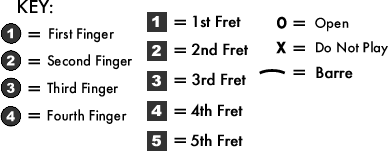G7sus4 Guitar Chord Tutorial
In this tutorial, you will be learning how to play the G7sus4 Guitar Chord (also known as G7 suspended 4th). You are welcome to skip right down to the chord charts below and give this chord a try or you can stick around to learn a little theory behind this chord.
This chord comes from the G Major scale.
Here is the G Major Scale: G A B C D E F#
Now, we need 4 notes from the above scale in order to build this chord. Which four notes you ask? Good question. Well, in order to find the notes needed to build this chord shape, we apply a simple little formula. That formula is: 1, 4, 5 and b7 or the notes: G, C, D and F. This just means that we take the 1st, 4th, 5th and 7th positions of the G Major scale. That little “b7” or “flattened 7th” symbol means that we take the 7th note of the G Major Scale (F#) and flatten it or go back 1/2 step. When we do this, we arrive at our “F” note.
Pretty easy stuff right?
G7sus4 Chord notes one more time: G, C, D and F
There are three voicings or variations of this chord featured in the chord charts below. Two of these voicings are barre chords. If you are still having difficulty playing barre chords, check out this post: Beginners Guide to Mastering Barre Chords. It contains a ton of resources including videos and articles that will help you to master barre chords like a pro.
Here is a key that will help you read the charts:

Everything on the above chart should be self explanatory, except for the last three in the third column. They may need a bit of explaining. The O, or open symbol, simply means that you do not press down on any notes on that string. The X means you do not strum that particular string. The Barre symbol means you need to barre that particular fret. When you barre a fret you are pressing down on multiple strings at the same time with one finger.



G7sus4 Guitar Chord Video Demonstration
Chord Playing Tip
Be sure that you are pressing down on the strings hard enough and play each string one at a time to make sure you have a nice clean sound. If any of the strings buzz or sound muted, then something is not right.